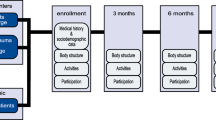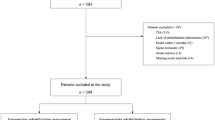Abstract
The aim of this study was to evaluate: 1) whether the reduction in duration of in-patient rehabilitation imposed by the Italian Ministry of Health’s circular of 29/6/95 has been accompanied by a decline in the results achieved; and 2) whether the system of basing payments on diagnosis related group (DRG) criteria is capable of correctly evaluating differences in post-stroke clinical pictures.
The study involved 461 of 497 patients consecutively admitted between 1991 and 1996 for rehabilitation after a first stroke. The average duration of hospitalisation for the period 1995–1996 was significantly shorter (p<0.001) than that of the previous years; at the same time, there was a significant increase (p<0.05) in the number of poor responders in both neurological and functional (mobility) terms. Furthermore, the early discharge after 60 days of the 1995–1996 patients compromised the stabilisation of recovery and led to a subsequent functional decline. It is therefore hoped that the current regulations will be revised and that payments based on a functional related group (FRG) criterion will be introduced.
Sommario
Scopo del nostro lavoro era di valutare se 1) la riduzione della durata della degenza riabilitativa imposta dalla circolare del Ministero della Sanità del 29/6/95 si sia accompagnata o meno ad un decremento dei risultati riabilitativi; 2) se la tariffazione in base a criteri DRG sia in grado di valutare correttamente le diverse realtà dei quadri clinici post-ictali.
Lo studio è stato completato da 461 pazienti su 497 pazienti ricoverati consecutivamente tra il 1994 ed il 1996 per riabilitazione di un primo episodio ictale. La durata media della degenza nel periodo 1995–1996 è risultata significativamente (p<0.001) più corta di quella degli anni precedenti. Nel contempo si è però osservato un significativo aumento (p<0.05) dei pazienti “low responder” sia sul recupero neurologico che funzionale (mobilità). Inoltre, nei pazienti del periodo 1995–1996 dimessi al 60° giorno la precoce dimissione ha compromesso la stabilizzazione del recupero con un successive? peggioramento funzionale. Si auspica pertanto che la normativa attuale venga rivista e che si arrivi ad una retta regolata secondo un criterio FRG.
Similar content being viewed by others
References
Khaw KT (1996) Epidemiology of stroke. J Neurol Neurosurg Psychiatry 61:333–338
Ministero della Sanità (1994) Decreto 15 aprile 1994. Determinazione dei criteri generali per la fissazione delle tariffe delle prestazioni di assistenza specialistica, riabilitativa ed ospedaliera. Gazzetta Ufficiale della Repubblica Italiana. Serie Generale n. 107:26–64
Ministero della Sanità (1994) Decreto 14 dicembre 1994. Tariffe delle prestazioni di assistenza ospedaliera. Gazzetta Ufficiale della Repubblica Italiana. Supplemento ordinario alla Serie Generale n. 300:3–55
Ministero della Sanità (1995) Linee di Guida n. 1/1995. Applicazione del decreto ministeriale 14 dicembre 1995 relativo alle “Tariffe delle prestazioni di assistenza ospedaliera”, con riferimento alla riorganizzazione della rete ospedaliera ed alle sue relazioni con i presidi e servizi extra-ospedalieri. Gazzetta Ufficiale della Repubblica Italiana. Serie Generale n. 150:46–55
Foulkes MA, Wolf PA, Price TR, Mohr JP, Hier DB (1988) The stroke data bank: Design, methods, and baseline characteristics. Stroke 19:547–554
Coté R, Battista RN, Wolfson C, Boucher J, Adam J, Hachinski V (1989) The Canadian Neurological Scale: Validation and reliability assessment. Neurology 39:638–643
Mahoney F, Barthel DW (1965) Functional evaluation: The Barthel Index. Mar State Med J Rehabil 14:61–65
Collen FM, Wade DT, Robb DT, Bradshaw CM (1991) The Rivermead Mobility Index: A further development of the Rivermead Motor Assessment. Int Disabil Stud 13:50–54
Shah S, Vanclay F, Cooper B (1990) Efficiency, effectiveness and duration of stroke rehabilitation. Stroke 21:241–246
Paolucci S, Antonucci G, Guariglia C, Magnotti L, Pizzamiglio L, Zoccolotti P (1996) Facilitatory effect of neglect rehabilitation on the recovery of left hemiplegic stroke patients: A cross-over study. J Neurol 243:308–314
Angeleri F, Angeleri VA, Foschi N et al (1993) The influence of depression, social activity, and family stress in functional outcome after stroke. Stroke 24:1478–1483
Ferrucci L, Bandinelli S, Guralnik JM et al (1993) Recovery of functional status after stroke. A post-rehabilitation follow-up study. Stroke 24:200–205
Paolucci S, Antonucci G, Emberti Gialloreti L, Traballesi M, Lubich S, Pratesi L, Palombi L (1996) Predicting stroke inpatient rehabilitation outcome: The prominent role of neuropsychological disorders. Eur Neurol 36:385–390
Wade DT, Wood VA, Langton Hewer R (1985) Recovery after stroke: The first three months. J Neurol Neurosurg Psychiatry 48:7–13
Johnston MV, Kirshblum S, Zorowitz R, Shiflett SC (1992) Prediction of outcomes following rehabilitation of stroke patients. Neurorehabil 2 (4):72–97
Denes G, Semenza C, Stoppa E, Lis A (1982) Unilateral spatial neglect and recovery from hemiplegia — a follow up study. Brain 105:543–552
Formisano R, Barbanti P, Catarci T et al (1993) Prolonged muscular flaccidity: Frequency and association with unilateral spatial neglect after stroke. Acta Neurol Scand 88:313–315
Ween JE, Alexander MP, D’Esposito M, Roberts M (1996) Factors predictive of stroke outcome in a rehabilitation setting. Neurology 47:388–392
Wilkerson DL, Batavia AL, DeJong G (1992) Use of functional status measures for payment of medical rehabilitation services. Arch Phys Med Rehabil 73:111–120
Mastrilli F, Taroni F (1996) Proposta di riorganizzazione e finanziamento delle attività di riabilitazione. Documento della Agenzia per i Servizi Sanitari Regionali
Taylor TN, Davis PH, Torner JC, Holmes J, Meyer JW, Jacobson MF (1996) Lifetime cost of stroke in United States. Stroke 27:1459–1566
Author information
Authors and Affiliations
Rights and permissions
About this article
Cite this article
Paolucci, S., Traballesi, M., Emberti Gialloreti, L. et al. Post-stroke rehabilitation: an economic or medical priority? Current issues and prospects in light of new legislative regulations. Ital J Neuro Sci 19, 25–31 (1998). https://doi.org/10.1007/BF03028808
Received:
Accepted:
Issue Date:
DOI: https://doi.org/10.1007/BF03028808




